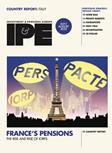FP Métal opens door for sector plans
When employers and trade unions in the Belgian metal industry came together in 1999 to discuss the formation of what was to become the Fonds de Pension Métal, it was the first time ever that a sector-wide plan had been contemplated to provide an occupation-related pension plan for a group ...
You have now reached your article limit
Already a registered user or member? Sign in here
To continue reading, register free today for access
Registration also includes access to

Five reasons to register today
- Access to IPE articles from our award-winning editorial team
- Unique IPE market data, rankings and tables
- In-depth interviews with pension fund leaders
- Extensive coverage of latest asset class trends
- Comprehensive archive of data, research and intelligence







